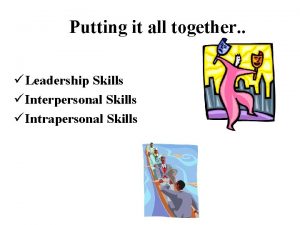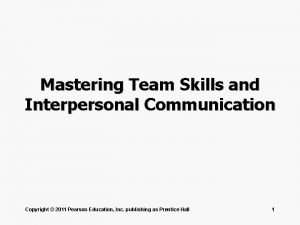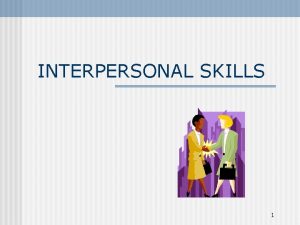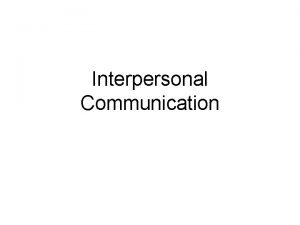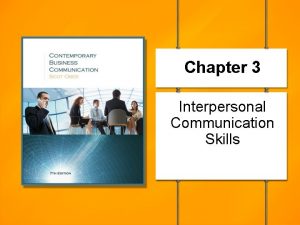INTERPERSONAL SKILLS MRS CURRY LECTURE NOTES CH 8














- Slides: 14

INTERPERSONAL SKILLS MRS. CURRY LECTURE NOTES CH. 8

TYPES OF QUESTIONING • Open-ended: broad in scope, requiring more than a single-word answer such as “yes” or “no. ” • Closed question: one that requires a very specific answer, often just one word. • Paraphrase: to repeat a message in your own words. • Small talk almost always takes on a superficial, somewhat distant tone. Does not involve strong opinions, feelings, or great detail. • Topics include- environment, personal characteristics, biography

SMALL TALK • Guidelines for Small talk • Check nonverbal signs- Is the other person really interested in talking to you? • Take the lead- Say something, introduce yourself. Offer a compliment. Comment on the weather, or say something funny. • Ask open-ended questions- This draws answers from a person and helps shy or reluctant conversationalists take an active role in the dialogue • Stick to safe topics- avoid personal or controversial topics such as politics, personal beliefs or values, religion, criticisms, etc. • Don’t rush!

MAINTAINING CONVERSATION • Tact- knowing what to do or say—or not do or say—to maintain a positive professional exchange • Why are tact and courtesy an important element of maintaining conversation?

MAKING REQUESTS • Requests for information- Use details (who, what, why, when, and how) • Requests to persuade- asking someone to do something

QUESTIONING STRATEGIES • Rephrase the message- repeat in your own words what the speaker has said • Ask for clarification- if you are not sure what the speaker said, ask them to clarify • Ask for more details- ask specific questions for specific details • Confirm through examples- verify that you understand with an example

LISTENING IN CONVERSATIONS • Listen to what is said • Listen empathically • Listen to what is left unsaid • Listen before you speak

PARAPHRASE V. SUMMARY • Summary: a brief sentence or two summing up what the speaker has said • Paraphrase: to repeat a message in your own words. (sometimes longer than what the original message is)

GIVING CLEAR & ACCURATE DIRECTIONS • Organize the steps • Avoid assumptions • Use details

PROFESSIONAL ETIQUETTE • Etiquette- an established code of behavior or courtesy • Protocol- a code of etiquette that is written and prescribed by an organization

GIVING CRITICISM • Constructive criticism- negative evaluation done in a way that brings about positive change • Descriptive communication- talk that paints a picture of the facts of a situation • Evaluative communication- talk that tells how you interpret a behavior and how you feel about a situation

GIVING CRITICISM • Describe the facts. • Evaluate the behavior. • Request change. • State the consequences.

HANDLING HOSTILE PHONE CALLS • • • Remain calm. Listen empathically. Keep your responses objective. Acknowledge the caller’s anger or hostility. Let the caller know that you want to help. Respond with clear, logical messages that reflect empathy with the caller.

DEALING WITH DIVERSITY • Culture • Gender • Ethnicity • Age
 01:640:244 lecture notes - lecture 15: plat, idah, farad
01:640:244 lecture notes - lecture 15: plat, idah, farad Intrapersonal skills
Intrapersonal skills They are mrs garcia and mrs castro
They are mrs garcia and mrs castro They are mrs garcia and mrs castro
They are mrs garcia and mrs castro Mrs. darling was ___________ of mrs. s.
Mrs. darling was ___________ of mrs. s. What is wikis
What is wikis Interpersonal vs intrapersonal
Interpersonal vs intrapersonal Interpersonal and intrapersonal skills ppt
Interpersonal and intrapersonal skills ppt Mastering team skills and interpersonal communication
Mastering team skills and interpersonal communication Basic interpersonal communication skills
Basic interpersonal communication skills Skills job application
Skills job application Conflict resolution is a(n) communication skill
Conflict resolution is a(n) communication skill Communication and interpersonal skills
Communication and interpersonal skills Barriers to interpersonal skills
Barriers to interpersonal skills Factors affecting interpersonal skills
Factors affecting interpersonal skills






